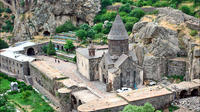Small Group Day Trip from Yerevan to Garni Temple, Geghard Monastery and Baking Demonstration
Yerevan, Armenia
Trip Type: Day Trips
Duration: 5 hours
Join the group to explore most amazing attractions of Armenia! First up visit Garni, the only pagan temple which exists in Armenia before moving onto Geghard monastery, a complex which is carved in a cave. Finally see the "Lavash" (Armenian bread) baking is one of the most beautiful and common Armenian national traditions.
More About This Activity All Day Trips →
Join the group to explore most amazing attractions of Armenia! First up visit Garni, the only pagan temple which exists in Armenia before moving onto Geghard monastery, a complex which is carved in a cave. Finally see the "Lavash" (Armenian bread) baking is one of the most beautiful and common Armenian national traditions.The tour starts at 10:00am from a central meeting point. You will first of all visit the Eastern part of Armenia and have a short stop at Charent's Arch, from where the wonderful view to Biblical mount Ararat is seen. The next stop is Garni pagan temple which towers over a triangular cape, is the unique survived example of heathen culture in Armenia. It is a blend of Greco-Roman and Armenian styles. King Trdat the First ordered building the temple in the first century A.D. and dedicated it to the God of Sun. After adopting Christianity in 301 the pagan temple lost its significance and the fortress of Garni became the summer residence of the kings. Nowadays the ruins of the roya palace and the bathroom with a stunning mosaic work can be found near the temple.
You will then visit Geghard monastery, the unsurpassed masterpiece of the 13th century Armenian architecture. Some of the churches of the complex are masterfully hewed in a huge rock. From the outset the complex was called Ayrivank (cave monastery), later it was renamed Geghard (lance), as the lance used by the roman soldier to sting Jesus Christ's side, was kept in this monastery for many centuries. Due to its construction Geghar-davank serves the best place for singing spiritual songs. The complex is rich in subtle sculptural embellishments and many striking khachkars (cross-stones).
The last stop is at "3 Jugs" family-style restaurant where Armenian bread "Lavash" baking procedure is presented. It is made with flour, water, and salt. The thickness of the bread varies depending on how thin it was rolled out. Toasted sesame seeds and/or poppy seeds are sometimes sprinkled on before baking. Traditionally the dough is rolled out flat and slapped against the hot walls of a clay oven. You will have a good opportunity to participate in "Lavash" baking procedure and after to taste it together with local cheese and greens.
You will then be returned to the meeting point.
You will then visit Geghard monastery, the unsurpassed masterpiece of the 13th century Armenian architecture. Some of the churches of the complex are masterfully hewed in a huge rock. From the outset the complex was called Ayrivank (cave monastery), later it was renamed Geghard (lance), as the lance used by the roman soldier to sting Jesus Christ's side, was kept in this monastery for many centuries. Due to its construction Geghar-davank serves the best place for singing spiritual songs. The complex is rich in subtle sculptural embellishments and many striking khachkars (cross-stones).
The last stop is at "3 Jugs" family-style restaurant where Armenian bread "Lavash" baking procedure is presented. It is made with flour, water, and salt. The thickness of the bread varies depending on how thin it was rolled out. Toasted sesame seeds and/or poppy seeds are sometimes sprinkled on before baking. Traditionally the dough is rolled out flat and slapped against the hot walls of a clay oven. You will have a good opportunity to participate in "Lavash" baking procedure and after to taste it together with local cheese and greens.
You will then be returned to the meeting point.
« Go Back

